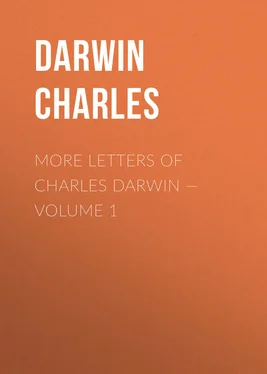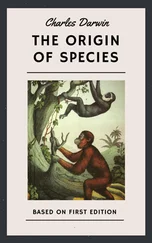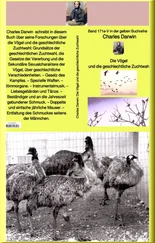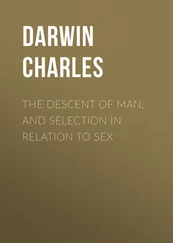Charles Darwin - More Letters of Charles Darwin — Volume 1
Здесь есть возможность читать онлайн «Charles Darwin - More Letters of Charles Darwin — Volume 1» — ознакомительный отрывок электронной книги совершенно бесплатно, а после прочтения отрывка купить полную версию. В некоторых случаях можно слушать аудио, скачать через торрент в формате fb2 и присутствует краткое содержание. Жанр: foreign_antique, foreign_prose, на английском языке. Описание произведения, (предисловие) а так же отзывы посетителей доступны на портале библиотеки ЛибКат.
- Название:More Letters of Charles Darwin — Volume 1
- Автор:
- Жанр:
- Год:неизвестен
- ISBN:нет данных
- Рейтинг книги:4 / 5. Голосов: 1
-
Избранное:Добавить в избранное
- Отзывы:
-
Ваша оценка:
- 80
- 1
- 2
- 3
- 4
- 5
More Letters of Charles Darwin — Volume 1: краткое содержание, описание и аннотация
Предлагаем к чтению аннотацию, описание, краткое содержание или предисловие (зависит от того, что написал сам автор книги «More Letters of Charles Darwin — Volume 1»). Если вы не нашли необходимую информацию о книге — напишите в комментариях, мы постараемся отыскать её.
More Letters of Charles Darwin — Volume 1 — читать онлайн ознакомительный отрывок
Ниже представлен текст книги, разбитый по страницам. Система сохранения места последней прочитанной страницы, позволяет с удобством читать онлайн бесплатно книгу «More Letters of Charles Darwin — Volume 1», без необходимости каждый раз заново искать на чём Вы остановились. Поставьте закладку, и сможете в любой момент перейти на страницу, на которой закончили чтение.
Интервал:
Закладка:
The "Beagle" left the Sts. of Magellan in the middle of winter; she found her road out by a wild unfrequented channel; well might Sir J. Narborough call the west coast South Desolation, "because it is so desolate a land to behold." We were driven into Chiloe by some very bad weather. An Englishman gave me three specimens of that very fine Lucanoidal insect which is described in the "Camb. Phil. Trans." (5/2. "Description of Chiasognathus Grantii, a new Lucanideous Insect, etc." by J.F. Stephens ("Trans. Camb. Phil. Soc." Volume IV., page 209, 1833.)), two males and one female. I find Chiloe is composed of lava and recent deposits. The lavas are curious from abounding in, or rather being in parts composed of pitchstone. If we go to Chiloe in the summer, I shall reap an entomological harvest. I suppose the Botany both there and in Chili is well-known.
I forgot to state that in the four cargoes of specimens there have been sent three square boxes, each containing four glass bottles. I mention this in case they should be stowed beneath geological specimens and thus escape your notice, perhaps some spirit may be wanted in them. If a box arrives from B. Ayres with a Megatherium head the other unnumbered specimens, be kind enough to tell me, as I have strong fears for its safety. We arrived here the day before yesterday; the views of the distant mountains are most sublime and the climate delightful; after our long cruise in the damp gloomy climates of the south, to breathe a clear dry air and feel honest warm sunshine, and eat good fresh roast beef must be the summum bonum of human life. I do not like the look of the rocks half so much as the beef, there is too much of those rather insipid ingredients, mica, quartz and feldspar. Our plans are at present undecided; there is a good deal of work to the south of Valparaiso and to the north an indefinite quantity. I look forward to every part with interest. I have sent you in this letter a sad dose of egotism, but recollect I look up to you as my father in Natural History, and a son may talk about himself to his father. In your paternal capacity as proproctor what a great deal of trouble you appear to have had. How turbulent Cambridge is become. Before this time it will have regained its tranquillity. I have a most schoolboy-like wish to be there, enjoying my holidays. It is a most comfortable reflection to me, that a ship being made of wood and iron, cannot last for ever, and therefore this voyage must have an end.
October 28th. This letter has been lying in my portfolio ever since July; I did not send it away because I did not think it worth the postage; it shall now go with a box of specimens. Shortly after arriving here I set out on a geological excursion, and had a very pleasant ramble about the base of the Andes. The whole country appears composed of breccias (and I imagine slates) which universally have been modified and oftentimes completely altered by the action of fire. The varieties of porphyry thus produced are endless, but nowhere have I yet met with rocks which have flowed in a stream; dykes of greenstone are very numerous. Modern volcanic action is entirely shut up in the very central parts (which cannot now be reached on account of the snow) of the Cordilleras. In the south of the R. Maypu I examined the Tertiary plains, already partially described by M. Gay. (5/3. "Rapport fait a l'Academie Royale des Sciences, sur les Travaux Geologiques de M. Gay," by Alex. Brongniart ("Ann. Sci. Nat." Volume XXVIII., page 394, 1833.) The fossil shells appear to me to be far more different from the recent ones than in the great Patagonian formation; it will be curious if an Eocene and Miocene (recent there is abundance of) could be proved to exist in S. America as well as in Europe. I have been much interested by finding abundance of recent shells at an elevation of 1,300 feet; the country in many places is scattered over with shells but these are all littoral ones. So that I suppose the 1,300 feet elevation must be owing to a succession of small elevations such as in 1822. With these certain proofs of the recent residence of the ocean over all the lower parts of Chili, the outline of every view and the form of each valley possesses a high interest. Has the action of running water or the sea formed this deep ravine? was a question which often arose in my mind and generally was answered by finding a bed of recent shells at the bottom. I have not sufficient arguments, but I do not believe that more than a small fraction of the height of the Andes has been formed within the Tertiary period. The conclusion of my excursion was very unfortunate, I became unwell and could hardly reach this place. I have been in bed for the last month, but am now rapidly getting well. I had hoped during this time to have made a good collection of insects but it has been impossible: I regret the less because Chiloe fairly swarms with collectors; there are more naturalists in the country, than carpenters or shoemakers or any other honest trade.
In my letter from the Falkland Islands I said I had fears about a box with a Megatherium. I have since heard from B. Ayres that it went to Liverpool by the brig "Basingwaithe." If you have not received it, it is I think worth taking some trouble about. In October two casks and a jar were sent by H.M.S. "Samarang" via Portsmouth. I have no doubt you have received them. With this letter I send a good many bird skins; in the same box with them, there is a paper parcel containing pill boxes with insects. The other pill boxes require no particular care. You will see in two of these boxes some dried Planariae (terrestrial), the only method I have found of preserving them (they are exceedingly brittle). By examining the white species I understand some little of the internal structure. There are two small parcels of seeds. There are some plants which I hope may interest you, or at least those from Patagonia where I collected every one in flower. There is a bottle clumsily but I think securely corked containing water and gas from the hot baths of Cauquenes seated at foot of Andes and long celebrated for medicinal properties. I took pains in filling and securing both water and gas. If you can find any one who likes to analyze them, I should think it would be worth the trouble. I have not time at present to copy my few observations about the locality, etc., etc., {of} these springs. Will you tell me how the Arachnidae which I have sent home, for instance those from Rio, appear to be preserved. I have doubts whether it is worth while collecting them.
We sail the day after to-morrow: our plans are at last limited and definite; I am delighted to say we have bid an eternal adieu to T. del Fuego. The "Beagle" will not proceed further south than C. Tres Montes; from which point we survey to the north. The Chonos Archipelago is delightfully unknown: fine deep inlets running into the Cordilleras — where we can steer by the light of a volcano. I do not know which part of the voyage now offers the most attractions. This is a shamefully untidy letter, but you must forgive me.
LETTER 6. TO J.S. HENSLOW. April 18th, 1835. Valparaiso.
I have just returned from Mendoza, having crossed the Cordilleras by two passes. This trip has added much to my knowledge of the geology of the country. Some of the facts, of the truth of which I in my own mind feel fully convinced, will appear to you quite absurd and incredible. I will give a very short sketch of the structure of these huge mountains. In the Portillo pass (the more southern one) travellers have described the Cordilleras to consist of a double chain of nearly equal altitude separated by a considerable interval. This is the case; and the same structure extends to the northward to Uspallata; the little elevation of the eastern line (here not more than 6,000-7,000 feet.) has caused it almost to be overlooked. To begin with the western and principal chain, we have, where the sections are best seen, an enormous mass of a porphyritic conglomerate resting on granite. This latter rock seems to form the nucleus of the whole mass, and is seen in the deep lateral valleys, injected amongst, upheaving, overturning in the most extraordinary manner, the overlying strata. The stratification in all the mountains is beautifully distinct and from a variety in the colour can be seen at great distances. I cannot imagine any part of the world presenting a more extraordinary scene of the breaking up of the crust of the globe than the very central parts of the Andes. The upheaval has taken place by a great number of (nearly) N. and S. lines; which in most cases have formed as many anticlinal and synclinal ravines; the strata in the highest pinnacles are almost universally inclined at an angle from 70 deg to 80 deg. I cannot tell you how I enjoyed some of these views — it is worth coming from England, once to feel such intense delight; at an elevation from 10 to 12,000 feet there is a transparency in the air, and a confusion of distances and a sort of stillness which gives the sensation of being in another world, and when to this is joined the picture so plainly drawn of the great epochs of violence, it causes in the mind a most strange assemblage of ideas.
Читать дальшеИнтервал:
Закладка:
Похожие книги на «More Letters of Charles Darwin — Volume 1»
Представляем Вашему вниманию похожие книги на «More Letters of Charles Darwin — Volume 1» списком для выбора. Мы отобрали схожую по названию и смыслу литературу в надежде предоставить читателям больше вариантов отыскать новые, интересные, ещё непрочитанные произведения.
Обсуждение, отзывы о книге «More Letters of Charles Darwin — Volume 1» и просто собственные мнения читателей. Оставьте ваши комментарии, напишите, что Вы думаете о произведении, его смысле или главных героях. Укажите что конкретно понравилось, а что нет, и почему Вы так считаете.












